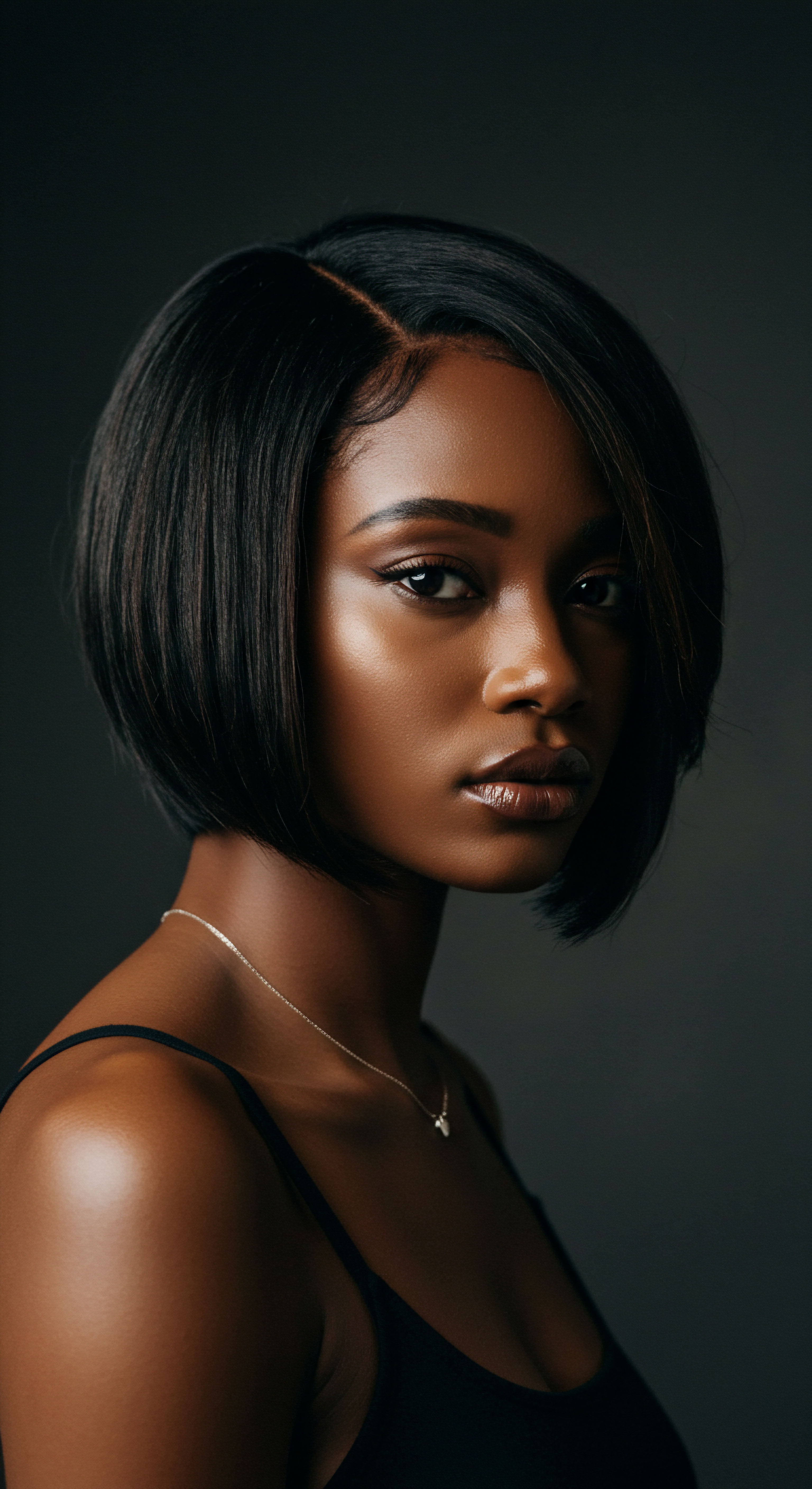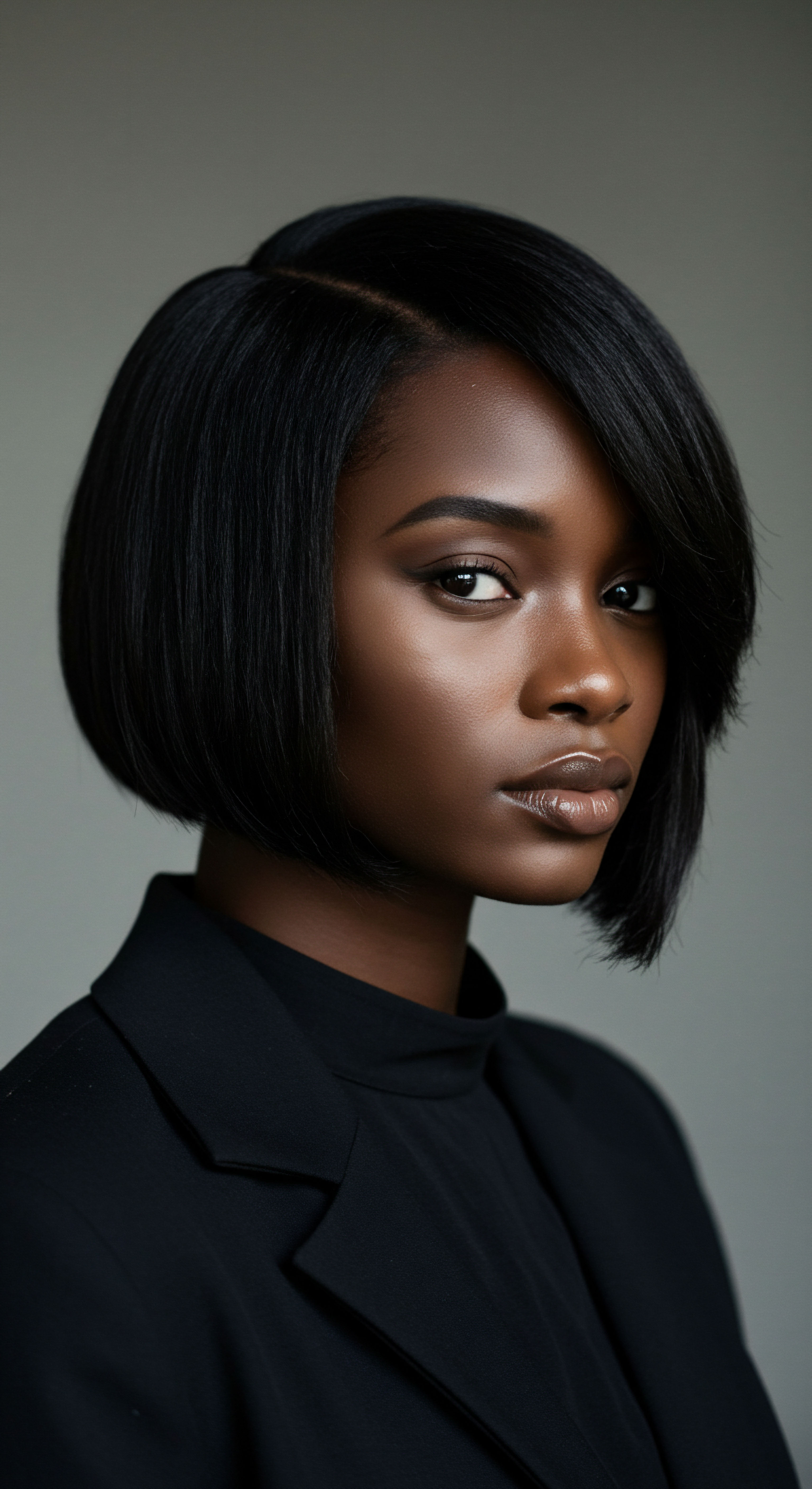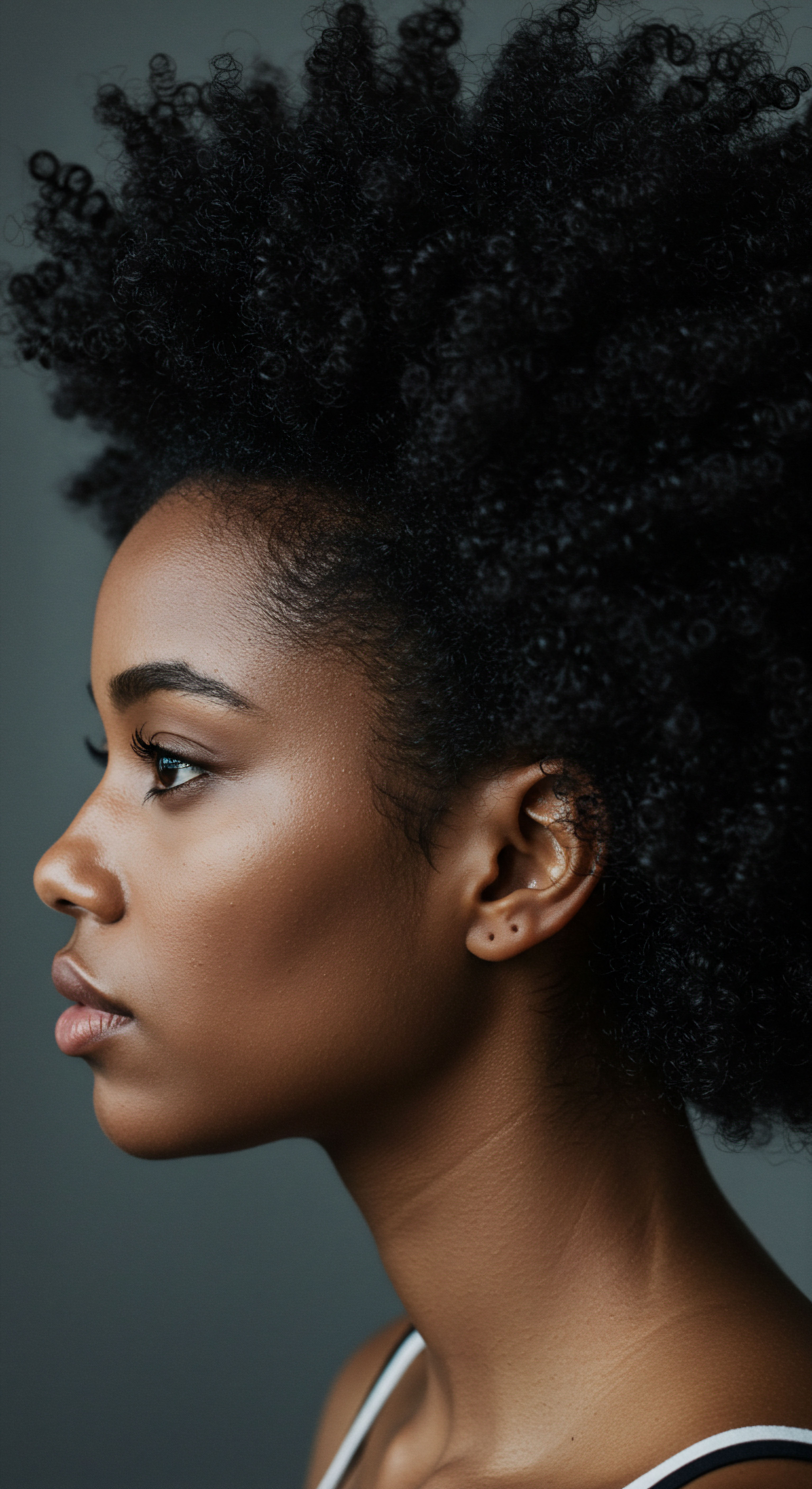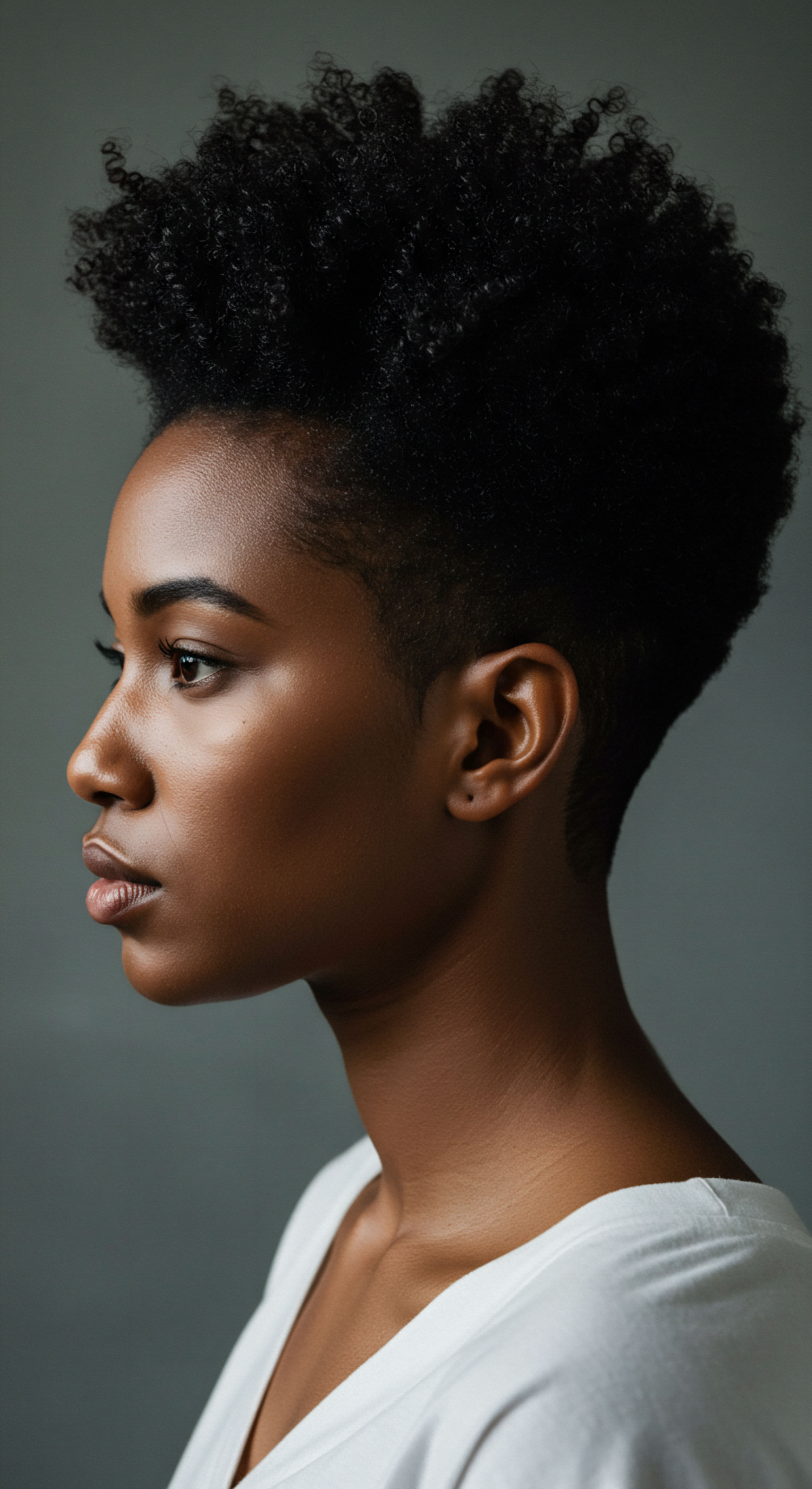
Roots
The quiet rustle of a young girl’s coils, the gentle spring of her kinks, the soft sway of her braids – these are not merely textures or styles. They are whispers of lineage, echoes of resilience, and declarations of self. Yet, for countless Black girls, these very expressions of identity become points of contention, grounds for exclusion, and sources of quiet hurt.
The query of how hair discrimination affects their well-being asks us to consider the very foundations of who they are, starting with the complex marvel that is textured hair itself. Before we can truly grasp the deep emotional and psychological toll, we must first honor the physical reality, the biological framework that so often becomes a site of struggle.

The Anatomy of Textured Hair
At its basic level, textured hair, frequently described as curly, coily, or kinky, holds a distinct architecture. Unlike straight strands that typically exhibit a circular cross-section, individual textured hair shafts often display an elliptical or even flattened shape. This structural variation guides how the hair emerges from the scalp, giving rise to the characteristic bends, twists, and spirals that lend textured hair its remarkable fullness and appearance.
The cuticle, the outermost protective covering of the hair, also behaves uniquely. In highly coiled hair, these cuticle scales may not lie as flat as on straight hair, contributing to its propensity for moisture loss and its distinctive dry look.
Understanding the precise formation of the hair follicle itself holds great importance. The follicle, the tiny organ beneath the skin that anchors the hair, determines the hair’s shape. In textured hair, the follicle often has a curved or S-shaped path, guiding the emerging strand into its unique curl pattern. This curvature influences the distribution of natural oils, or sebum, from the scalp down the hair shaft.
Sebum, a vital moisturizer, struggles to travel effectively along a highly coiled strand, leaving the ends particularly vulnerable to dryness and breakage. This inherent characteristic underscores the critical need for specific care practices that prioritize hydration and safeguarding.
Beyond the macroscopic view, the micro-anatomy of textured hair reveals further distinctions. The distribution of keratin, the protein that forms hair, and the presence of disulfide bonds, which contribute to hair’s strength and shape, differ across hair types. These subtle variations contribute to the unique mechanical properties of textured hair, such as its elasticity and susceptibility to breakage under tension.
Chemical treatments, such as relaxers, alter these bonds, forcing the hair into a straightened configuration. While historically a means to conform, these processes often compromise the hair’s structural integrity, leading to increased fragility and a reliance on further chemical intervention.
The very structure of textured hair, from its elliptical cross-section to its curved follicle, inherently shapes its care requirements and unique beauty.

Hair Classification Systems and Their Cultural Weight
For many years, discussions around hair type relied on informal descriptions. However, more structured classification systems have arisen to provide a common language for grasping the vast array of textured hair. While various systems exist, one popular method sorts hair by its curl pattern, typically ranging from Type 1 (straight) to Type 4 (kinky/coily), with subcategories for different degrees of wave, curl, or coil. For instance, Type 4C Hair is characterized by tightly packed, zig-zag coils that may appear shorter than their actual length due to shrinkage.
These classifications, while helpful for communication and product selection, carry a deeper social weight, particularly within the context of discrimination. Historically, looser curl patterns have been deemed more “acceptable” or “professional” in dominant societal norms, creating a hierarchy that devalues tighter textures. This subtle, yet pervasive, societal bias often begins to appear in young girls, shaping their perceptions of their own hair and, by extension, their worth. A full grasp of these systems, therefore, extends beyond mere technicality; it touches upon the very cultural setting in which Black girls direct their hair identities.

What Does Hair Texture Classification Reveal About Societal Perceptions?
The very act of classifying hair, particularly within a social context, frequently uncovers underlying biases. When certain hair types are consistently linked with negative descriptors or deemed “unruly” or “unprofessional,” it speaks volumes about the societal lens through which Black hair is viewed. This societal gaze, often rooted in historical prejudices, can translate into tangible discriminatory practices, particularly within institutions like schools and workplaces.
It reinforces a Eurocentric ideal of beauty, making anything that deviates from it a target for disapproval. This can lead to a sense of “otherness” for Black girls, making them question their natural appearance.
| Hair Type Category Type 3 |
| General Curl Pattern Loose curls to tight, springy spirals |
| Common Features Defined curls, often with a visible S-pattern, can be prone to dryness. |
| Hair Type Category Type 4A |
| General Curl Pattern Tightly coiled S-pattern |
| Common Features Dense, springy coils, visible curl pattern, prone to shrinkage. |
| Hair Type Category Type 4B |
| General Curl Pattern Tightly coiled Z-pattern |
| Common Features Sharp, angular bends, less defined curl pattern, significant shrinkage. |
| Hair Type Category Type 4C |
| General Curl Pattern Very tight, zig-zag coils |
| Common Features Smallest, densest coils, least defined curl pattern, maximum shrinkage. |
| Hair Type Category Understanding these categories helps in recognizing the broad range of Black hair. |

The Language of Textured Hair
Beyond classification systems, a rich vocabulary has developed within the textured hair community. Terms like Porosity, referring to how well hair takes in and holds moisture, and Density, the number of individual hair strands on the scalp, are central to personalized care. Grasping these attributes allows for a more intuitive and effective approach to hair health, moving beyond general advice to truly tailored regimens. This specific vocabulary empowers individuals to communicate their hair needs with precision, rather than relying on generalized descriptions that may not fully apply to their unique texture.
Other important terms include Shrinkage, the apparent reduction in hair length due to its coil pattern when dry, and Coily, a descriptor for very tightly wound strands. These terms not only describe physical characteristics but also hold cultural weight, mirroring shared experiences and understandings within the community. For Black girls, acquiring this language can be an act of self-affirmation, providing them with the tools to describe, comprehend, and celebrate their hair on their own terms, rather than through the limited vocabulary of dominant beauty standards. This shared language creates a sense of belonging and collective wisdom.
- Porosity ❉ How hair takes in and holds moisture.
- Density ❉ The count of individual hair strands on the scalp.
- Shrinkage ❉ The visible length reduction of coiled hair when dry.
- Coily ❉ A descriptor for very tightly wound strands.
The very words we use to speak of hair possess the ability to either affirm or diminish. When school policies or media portrayals label natural hair as “messy” or “unprofessional,” they strip away the dignity inherent in its structure and cultural significance. Conversely, when terms like “crown” or “coil power” are used, they uplift and celebrate. This conscious choice of language forms a protective shield around the self-perception of Black girls, guiding them towards a positive relationship with their hair from a young age.

Ritual
The daily care of textured hair is far more than a mere chore; it is a thoughtful practice, a dialogue between oneself and the strands that crown the head. For Black girls, these practices often extend beyond simple aesthetics, becoming quiet acts of self-preservation and expressions of cultural connection. As we move from the foundational comprehension of hair’s structure, our gaze turns to the applied wisdom, the techniques, and the gentle considerations that shape the lived experience of hair, particularly when confronted with the shadow of discrimination. This section offers a gentle guide through the purposeful routines that nourish and safeguard, providing practical knowledge that reinforces self-worth.

Protective Styling and Its Purpose
Protective styles, such as braids, twists, and cornrows, serve a dual purpose for textured hair. They shield the delicate ends from environmental stressors, lessening breakage and supporting length retention. Beyond their functional benefits, these styles carry deep cultural meaning, often passed down through generations. They represent artistry, community, and a rich legacy of adornment.
For Black girls, protective styles can be a source of comfort and pride, allowing them to express their identity while preserving their hair’s condition. The time spent in styling, often with family members, can also be a bonding experience, reinforcing familial and cultural ties.
However, these very styles, so rooted in cultural tradition and practical care, are frequently targets of discrimination. School policies, often seemingly neutral, can disproportionately affect Black girls by banning braids with extensions or styles deemed “unnatural.” This creates a deep dilemma ❉ conform to a standard that rejects their heritage and harms their hair, or stand firm in their identity and face potential disciplinary action. The decision itself, often made at a young age, can plant seeds of anxiety and self-doubt. The act of choosing a style becomes laden with external judgment, transforming a personal expression into a potential point of conflict.

Why Are Protective Styles Often Misunderstood in Formal Settings?
The misunderstanding surrounding protective styles in formal environments frequently stems from a lack of cultural awareness and an unconscious bias against Black aesthetics. What is seen as neat and professional for one group may be viewed as distracting or unprofessional for another, simply because it deviates from a Eurocentric norm. This disparity highlights a broader societal issue where natural Black hair, and the styles that best suit it, are not afforded the same respect or acceptance as other hair types.
This can be particularly frustrating for young girls who see their peers wearing similar styles without issue, while their own are singled out for critique. The problem lies not with the hair itself, but with the narrow lens through which it is perceived.

Natural Styling and Definition Techniques
Celebrating natural hair involves a range of techniques aimed at enhancing its inherent beauty. Wash-and-gos, twist-outs, and braid-outs are popular methods for defining curl patterns and adding volume. These techniques prioritize working with the hair’s natural texture rather than attempting to alter it.
The process often involves carefully chosen products that provide moisture and hold, allowing the curls to clump and coil in their unique formations. The tactile experience of applying products and shaping coils can be a meditative act, connecting the individual to their hair’s natural rhythm.
For Black girls, learning to style their natural hair can be a path of discovery and self-acceptance. It can cultivate a deep connection to their physical self and their heritage. Yet, the pressure to straighten hair for “important” events or to avoid scrutiny at school or in social settings can undermine this personal exploration.
The joy of seeing one’s natural coils defined can be overshadowed by the fear of judgment or the direct experience of discrimination. This external pressure can lead to a disconnect between a girl’s inner sense of beauty and the external validation she seeks.
- Wash-And-Go ❉ Styling by simply washing and conditioning, then applying product to define natural curls.
- Twist-Out ❉ A styling method where hair is twisted into sections, allowed to dry, then unraveled for defined, elongated curls.
- Braid-Out ❉ Similar to a twist-out, but hair is braided into sections before drying and unraveling.
The selection of appropriate products also plays a vital role in natural styling. Products formulated for textured hair often contain humectants, emollients, and occlusives to address its specific moisture needs. Understanding the science behind these ingredients, such as how humectants draw moisture from the air or how emollients soften the hair, allows for more informed product choices. This scientific understanding, paired with intuitive application, transforms styling into a deliberate act of care.

The Nighttime Sanctuary Essential Sleep Protection
The care of textured hair extends far beyond daytime styling; nighttime rituals are just as important for maintaining health and integrity. Sleep protection, primarily through the use of satin or silk bonnets, scarves, or pillowcases, is a core aspect of this care. These materials lessen friction against the hair, preventing tangles, frizz, and breakage that can occur with cotton.
They also help to preserve moisture, keeping strands hydrated and supple overnight. The quiet routine of preparing hair for sleep becomes a moment of tender self-care, a shield against the day’s potential aggressions.
For many Black girls, the bonnet becomes a symbol of self-care, a quiet guardian of their coils as they rest. It is a simple yet deeply effective tool in their hair care regimen. Yet, even this private act of protection can be subject to public scrutiny. There are instances where bonnets worn in public, even in casual settings, have been deemed inappropriate or unprofessional, showing how the gaze of discrimination can extend to even the most personal aspects of Black girls’ lives.
This constant vigilance, this awareness of being judged for choices related to their hair, adds another layer of stress to their daily existence. The bonnet, a symbol of care, can become a point of public vulnerability.
The very act of securing hair for sleep speaks to a wisdom passed down through generations – a practical knowledge of how to preserve delicate textures. This nightly custom, often shared between mothers and daughters, reinforces not only hair health but also a sense of connection to a larger cultural practice. It is a gentle reminder that care, in its truest sense, is both scientific and deeply personal, guarding both the physical strand and the spirit of the wearer.

Relay
How does the external world’s gaze, particularly one steeped in historical bias, seep into the very core of a young Black girl’s being? The influence of hair discrimination extends far beyond the surface, reaching into the delicate architecture of self-perception, academic engagement, and psychological health. This discussion invites us to consider the deep reverberations of seemingly simple rules or comments about hair, tracing their paths through biological responses, emotional landscapes, and the broader societal arrangements that shape young lives. It is a deeper inquiry into the connectedness of hair, identity, and well-being.

Psychological Repercussions of Hair Scrutiny
The consistent scrutiny and devaluation of natural Black hair can inflict significant psychological distress on young girls. When a girl is told her hair is “distracting,” “messy,” or “unprofessional,” it communicates a potent message ❉ that a fundamental aspect of her being is unacceptable. This can lead to internalized negativity, where the child begins to associate her natural hair with shame or inadequacy.
This internalized perception can erode self-esteem and self-worth, vital building blocks of a healthy psychological foundation. The repeated exposure to such messages can contribute to a negative body image, specifically concerning their hair, which is closely tied to their overall sense of self.
Moreover, the anticipation of discrimination can generate a chronic state of vigilance. Black girls may spend undue mental energy worrying about their hair, choosing styles not for personal expression or hair health, but to avoid disciplinary action or negative comments. This constant mental burden, often termed Racial Battle Fatigue in broader contexts, diverts cognitive resources away from learning and social interaction, contributing to anxiety and stress. This constant state of alert can manifest as hyper-awareness of their appearance, leading to self-consciousness and a diminished sense of freedom in expressing their identity.
Hair discrimination, often subtle, can lead to internalized negativity and a chronic state of vigilance, greatly affecting a young girl’s psychological well-being.

Does Hair Discrimination Undermine Academic Progress?
The link between hair discrimination and academic performance is not immediately obvious, yet research sheds light on a troubling connection. When Black girls face disciplinary actions, such as suspensions or being sent home, because of their hair, they miss valuable instructional time. This direct loss of learning opportunities can lead to academic setbacks, widening achievement gaps.
Beyond direct disciplinary actions, the psychological stress and feeling of being unwelcome can significantly impair a student’s ability to focus and engage in the classroom. The emotional burden of being targeted for one’s appearance can overshadow the joy of learning, leading to disengagement.
A significant study by Dove and the CROWN Coalition in 2019, surveying over 2,000 women and girls, revealed striking statistics concerning this issue. Their findings indicated that Black Girls, as Young as Five Years Old, are 2.5 Times More Likely to Be Sent Home from School or Face Suspension Due to Their Hair Than White Girls. This data point is not merely a statistic; it represents countless instances of interrupted education, emotional distress, and the deep message that a child’s natural appearance is a barrier to their learning. Such experiences can lead to disengagement from school, a sense of injustice, and a diminished belief in the fairness of educational institutions.
The cumulative effect of these seemingly isolated incidents can be a deep and lasting negative influence on a girl’s academic trajectory and her relationship with learning. Furthermore, research from Arizona State University indicates that negative hair experiences are normative for young Black girls, with 78% of 10-year-olds reporting unwanted hair touching, and negative feedback about natural Black hair at school being a common experience. This consistent negative reinforcement from school environments, whether from peers or staff, can lead to a lack of confidence in academic settings.

Societal and Cultural Considerations
Hair discrimination is not an isolated occurrence; it is deeply set within broader societal structures that perpetuate racial bias. It serves as a smaller representation of larger systemic issues, reflecting historical attempts to control and devalue Black bodies and identities. The pressure to conform to Eurocentric beauty standards is a legacy of colonialism and slavery, where straight hair was equated with civility and beauty, while textured hair was deemed “other” and undesirable. This historical context is vital for grasping the depth of the harm.
When Black girls are penalized for their hair, it reinforces a message that their cultural heritage is inferior or unwelcome in mainstream spaces. This can lead to a sense of cultural alienation, where they feel compelled to suppress their authentic selves to gain acceptance. The struggle over hair becomes a struggle for identity, for belonging, and for the right to exist authentically in the world. The constant need to defend one’s natural hair or alter it to fit in can also limit cultural expression and the celebration of ancestral styles.
| Dimension of Well-Being Psychological Health |
| Dimension of Well-Being Academic Engagement |
| Dimension of Well-Being Social Development |
| Dimension of Well-Being The repercussions extend across psychological, academic, and social spheres, affecting a child's entire existence. |

Biological Responses to Chronic Stress
The chronic stress induced by hair discrimination can appear in physiological ways. The body’s stress response system, when constantly activated, can lead to elevated cortisol levels. Prolonged high cortisol can have various negative health outcomes, including influences on sleep, mood, and even physical health.
While direct studies linking hair discrimination to specific biological markers in young girls are appearing, the broader scientific understanding of chronic psychological stress points to a clear pathway for physiological influence. The weight of societal judgment, carried daily, is not merely an emotional burden; it can be a biological one too.
Research on the physiological reactions to racism and discrimination, while not always hair-specific, consistently shows that such experiences trigger stress responses, including changes in heart rate and blood pressure. For young Black girls, the repeated microaggressions and overt acts of hair discrimination contribute to this cumulative stress load. This sustained activation of the stress response system can, over time, lead to wear and tear on the body, contributing to long-term health disparities.
This interplay between external prejudice and internal physiological response underscores the seriousness of hair discrimination. It is not a trivial matter of appearance; it is a deep assault on a child’s holistic well-being, demanding recognition and thoughtful, systemic remedies.

Reflection
The path through the varied landscape of textured hair, from its inherent structure to the deep influence of societal biases, brings us to a quiet moment of contemplation. The experiences of Black girls confronting hair discrimination are not isolated occurrences but rather strands joined into the larger pattern of their lives, shaping their self-perception, their educational paths, and their very sense of belonging. Recognizing the depth of this challenge invites us to move beyond mere tolerance towards genuine understanding and celebration.
It beckons us to create spaces where every coil, every braid, every natural style is seen not as a problem to be managed, but as a unique expression of beauty and heritage, fully worthy of respect and adoration. It is in this collective recognition and active valuing that the true potential for healing and authentic self-expression for Black girls can begin to truly take shape.

References
- The CROWN Coalition, Dove, and National Urban League. (2019). The CROWN Research Study ❉ Perceptions of Beauty, Bias, and Black Women’s Hair.
- Thompson, R. (2009). Black Women and Identity ❉ A Critical Analysis of the Black Hair Phenomenon. Palgrave Macmillan.
- Banks, I. (2000). Hair Matters ❉ Beauty, Power, and the Politics of African American Women’s Hair. New York University Press.
- Patton, T. O. (2006). Blowing the Lid Off the Texturized Hair Controversy ❉ The Sociocultural Influence of Hair Straightening on Black Women. In Women, Race, and Class in the South (pp. 147-164). Routledge.
- Caldwell, J. (2020). Hair Story ❉ Untangling the Roots of Black Hair in America. St. Martin’s Press.
- Neal, A. M. & Wilson, M. L. (1989). The role of skin color and hair texture in the social perception of African American women. Journal of Applied Social Psychology, 19(15), 1177-1188.
- Lisse, A. (2025). Hair Satisfaction and Depressive Symptoms Among Black Adolescent Girls ❉ A Cross-Sectional Study. Body Image.
- Perez, M. & Ismael, L. (2022). Negative Experiences Related to Hair Are Normative for Young Black Girls. Body Image.
- Goosby, B. J. & Heidbrink, A. (2021). Tracking Real-Time Physiological Reactions to Racism. Proceedings of the National Academy of Sciences.
- Harrell, S. P. & Siddique, J. (2003). Physiological Responses to Racism and Discrimination ❉ An Assessment of the Evidence. American Journal of Public Health, 93(2), 274–279.
- Norris, A. N. (2021). Hair Discrimination, Anti-Black Racism, and Resistance. African American Intellectual History Society.
- Mbilishaka, A. & Apugo, D. (2020). PsychoHairapy ❉ Brushing Up on the History and Psychology of Black Hair. Psi Chi Journal of Psychological Research, 25(4), 312-325.